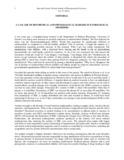| dc.description.abstract | A few years ago, a neurophysiology lecturer in the Department of Medical Physiology, University of
Nairobi, was doing some research on possible indicators in malnourished children. The first indicator he
chose was the electroencephalogram (EEG). Would this parameter be significantly different in
malnourished as compared to well-fed healthy children? Out of curiosity, I sought the opinion of a
paediatrician regarding possible outcome of this research. What I got was totally unexpected. The
paediatrician went ballistic; with a furrowed brow, hissing and his hands in the air gesticulating
spasmodically, he could hardly control his emotions. As far as he was concerned, the only answer the
researcher would get would be “I am hungry, I am hungry, I am hungry, feed me!” Paediatricians are
known to get emotional when the welfare of their patients is threatened but clearly the procedure of
getting EEG is much less invasive than getting blood for diagnostic purposes. So what provoked the
paediatrician? This could best be answered by posing a rhetorical question: “Why do we disapprove the
use of pictures of malnourished African children and elderly people by religious missionaries and nongovernmental
organizations (NGOs) to solicit funds from foreign donors?” | en_US |

